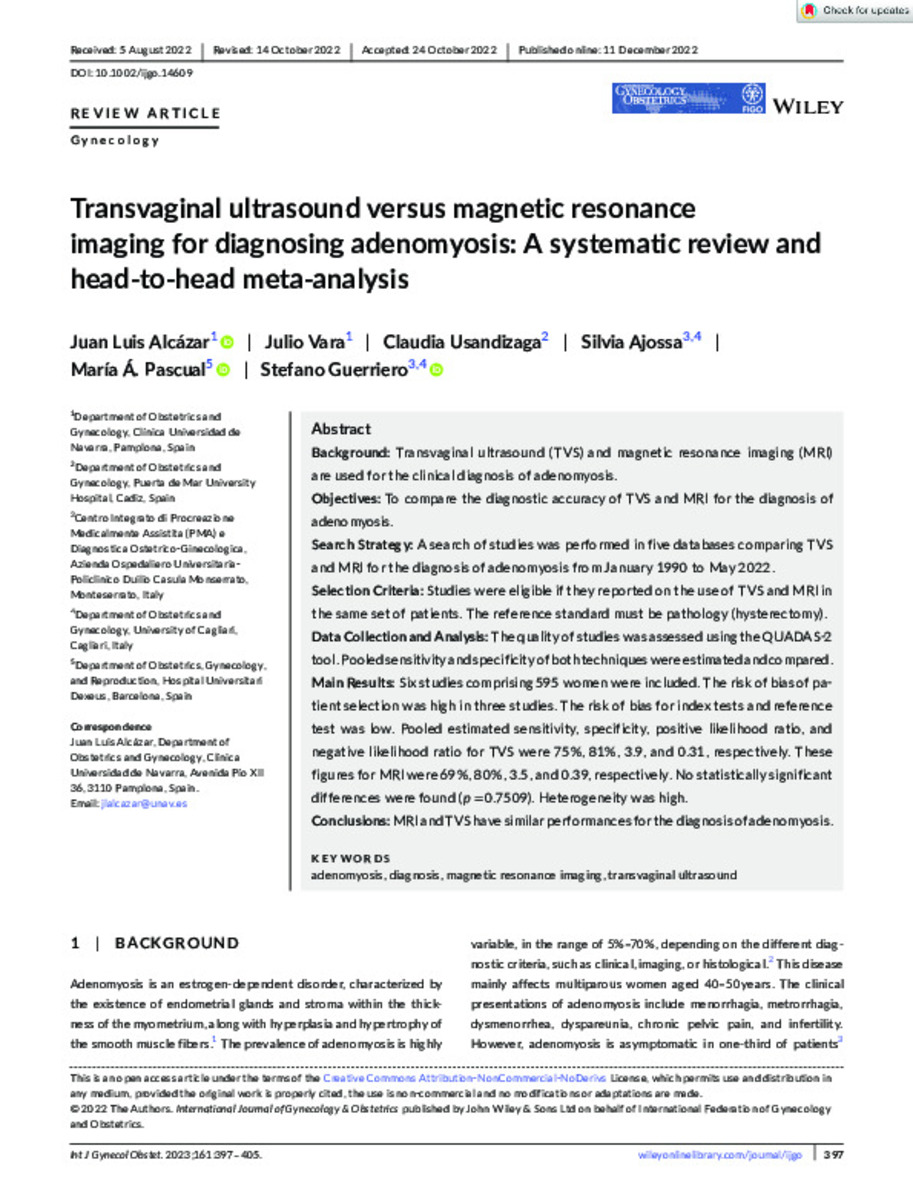Full metadata record
| DC Field | Value | Language |
|---|---|---|
| dc.creator | Alcazar, J.L. (Juan Luis) | - |
| dc.creator | Vara, J. (J.) | - |
| dc.creator | Usandizaga, C. (Claudia) | - |
| dc.creator | Ajossa, S. (Silvia) | - |
| dc.creator | Pascual, M.A. (Maria Angela) | - |
| dc.creator | Guerriero, S. (Stefano) | - |
| dc.date.accessioned | 2024-02-13T11:45:34Z | - |
| dc.date.available | 2024-02-13T11:45:34Z | - |
| dc.date.issued | 2022 | - |
| dc.identifier.citation | Alcazar, J.L. (Juan Luis); Vara, J. (J.); Usandizaga, C. (Claudia). "Transvaginal ultrasound versus magnetic resonance imaging for diagnosing adenomyosis: A systematic review and head-to-head meta-analysis". International Journal of Gynecology & Obstetrics. 161 (2), 2022, 397 - 405 | es_ES |
| dc.identifier.issn | 1879-3479 | - |
| dc.identifier.uri | https://hdl.handle.net/10171/69093 | - |
| dc.description.abstract | Background: Transvaginal ultrasound (TVS) and magnetic resonance imaging (MRI) are used for the clinical diagnosis of adenomyosis. Objectives: To compare the diagnostic accuracy of TVS and MRI for the diagnosis of adenomyosis. Search strategy: A search of studies was performed in five databases comparing TVS and MRI for the diagnosis of adenomyosis from January 1990 to May 2022. Selection criteria: Studies were eligible if they reported on the use of TVS and MRI in the same set of patients. The reference standard must be pathology (hysterectomy). Data collection and analysis: The quality of studies was assessed using the QUADAS-2 tool. Pooled sensitivity and specificity of both techniques were estimated and compared. Main results: Six studies comprising 595 women were included. The risk of bias of patient selection was high in three studies. The risk of bias for index tests and reference test was low. Pooled estimated sensitivity, specificity, positive likelihood ratio, and negative likelihood ratio for TVS were 75%, 81%, 3.9, and 0.31, respectively. These figures for MRI were 69%, 80%, 3.5, and 0.39, respectively. No statistically significant differences were found (p = 0.7509). Heterogeneity was high. Conclusions: MRI and TVS have similar performances for the diagnosis of adenomyosis. | es_ES |
| dc.language.iso | eng | es_ES |
| dc.publisher | Wiley | es_ES |
| dc.rights | info:eu-repo/semantics/openAccess | es_ES |
| dc.subject | Adenomyosis | es_ES |
| dc.subject | Diagnosis | es_ES |
| dc.subject | Magnetic resonance imaging | es_ES |
| dc.subject | Transvaginal ultrasound | es_ES |
| dc.title | Transvaginal ultrasound versus magnetic resonance imaging for diagnosing adenomyosis: A systematic review and head-to-head meta-analysis | es_ES |
| dc.type | info:eu-repo/semantics/article | es_ES |
| dc.description.note | This is an open access article under the terms of the Creative Commons Attribution-NonCommercial-NoDerivs License | es_ES |
| dc.identifier.doi | 10.1002/ijgo.14609 | - |
| dadun.citation.endingPage | 405 | es_ES |
| dadun.citation.number | 2 | es_ES |
| dadun.citation.publicationName | International Journal of Gynecology & Obstetrics | es_ES |
| dadun.citation.startingPage | 397 | es_ES |
| dadun.citation.volume | 161 | es_ES |
| dc.identifier.pmid | 36461921 | - |
Files in This Item:
Statistics and impact
Items in Dadun are protected by copyright, with all rights reserved, unless otherwise indicated.






